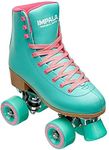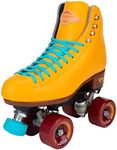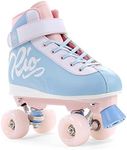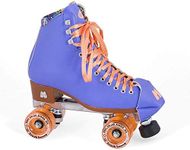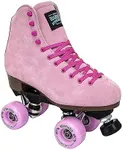Buying Guide for the Best Roller Skates
Choosing the right pair of roller skates can greatly enhance your skating experience, whether you're a beginner or an experienced skater. The key is to understand the different components and features of roller skates, which will help you select a pair that suits your needs and skating style. Consider where you plan to skate, your skill level, and the type of skating you want to do, as these factors will guide you in making the best choice.Boot TypeThe boot type of roller skates is crucial as it affects comfort, support, and performance. There are mainly two types: high-top and low-top boots. High-top boots offer more ankle support and are ideal for beginners or those interested in artistic skating. Low-top boots provide more freedom of movement and are preferred by speed skaters or those interested in roller derby. Choose a boot type based on your skating style and the level of support you need.
Wheel SizeWheel size impacts the speed and maneuverability of roller skates. Smaller wheels (around 54-62mm) are more agile and suitable for indoor skating or tricks, while larger wheels (62-70mm) provide more speed and are better for outdoor skating. Consider where you will be skating most often and choose a wheel size that matches your needs for speed and control.
Wheel HardnessWheel hardness, measured in durometer (A scale), affects grip and durability. Softer wheels (78A-85A) offer more grip and are better for outdoor surfaces, providing a smoother ride over rough terrain. Harder wheels (85A-100A) are more durable and faster on smooth indoor surfaces. Determine the type of surface you will skate on most frequently to select the appropriate wheel hardness.
BearingsBearings determine how smoothly and quickly the wheels spin. They are rated using the ABEC scale, with higher numbers indicating more precision and potentially faster speeds. However, for most skaters, the difference in ABEC ratings is minimal. Focus on the quality of the bearings rather than just the rating, and consider your need for speed and smoothness when choosing bearings.
Plate MaterialThe plate material of roller skates affects their weight and durability. Plates are typically made from nylon or metal. Nylon plates are lighter and more affordable, making them a good choice for beginners or casual skaters. Metal plates, such as aluminum, are more durable and provide better power transfer, preferred by more advanced skaters or those involved in competitive skating. Consider your level of skating and how much durability you need when selecting plate material.
Fit and ComfortFit and comfort are essential for an enjoyable skating experience. Skates should fit snugly but not too tight, allowing for some movement without causing blisters or discomfort. Consider trying on different brands and models to find the best fit for your foot shape. Pay attention to the padding and support inside the boot, as these will affect your comfort during long skating sessions. Prioritize comfort to ensure you can skate for extended periods without pain.




